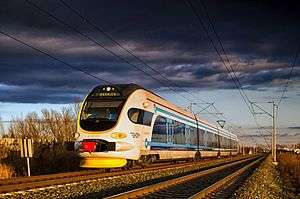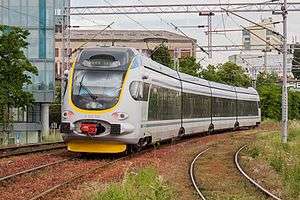HŽ series 6112
| HŽ 6112 | |||||||||||||
|---|---|---|---|---|---|---|---|---|---|---|---|---|---|
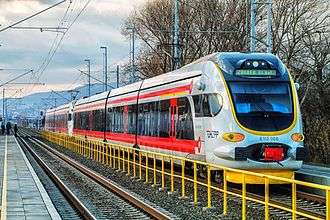 Croatian Regional Electrical Multiple Unit | |||||||||||||
| |||||||||||||
| |||||||||||||
| |||||||||||||
| |||||||||||||
HŽ series 6112 is a class of low-floor electrical multiple unit on order for Croatian Railways (Croatian: hrvatske željeznice, HŽ) and Railways of the Federation of Bosnia and Herzegovina. Croatian Railways issued international tender for supply of Electric and Diesel Passenger Trains to replace old and obsolete stock. Končar Group won the tender to supply initially 18 EMU train sets for local Zagreb Commuter Rail network, with order of up to 92 trains for the entire Croatian Railway Network to be delivered by 2016. Bosnian Railways also ordered initially one intercity train, with no indication if Bosnian railways might order additional units.
The prototype made its first test run at the Zagreb – Dugo Selo line on July 3, 2011.[2]
The construction, design and driving characteristics of the low-floor electric train enable successful implementation and superb traveling comfort in regional passenger traffic in regard to the length of the route.
Passenger space is uniform along the entire train, without partitions and stairs. Floor height is optimal for 550 mm high platforms. The train has up to eight doors on each side, which enables the rapid exchange of passengers, and an air-conditioned passenger compartment and driver’s cab.
The main frame is a four-part welded steel construction linked with joints. The body consists of aluminum sandwich panels and windows. All bogies are equipped with air suspension systems, and two side drive bogies, while three free bogies are of the Jacobs type.
Three-phase asynchronous traction motors, fed from an electronic IGBT inverter provide high acceleration at start-up and a maximum speed of 200 km/h. The steering and diagnostic system is a microprocessor system that links the train subsystems with modern communication protocols that allow for linking up to three trains into one.
Main characteristics of EMU (Electric Multiple Unit)
- bright, passenger-friendly interior with customized design
- end-to-end walk-through passenger compartment, with no steps
- up to 8 doors on each side for rapid passenger access
- air-conditioned passenger and driver compartments
- vacuum toilet-system, also suitable for disabled persons
- ergonomically designed driver’s cab
- welded steel construction, glued aluminium sandwich panels
- glass-fibre reinforced front section with automatic coupling
- air-suspended bogies
- redundant traction chain with IGBT power converters
- microprocessor vehicle control system with train bus and diagnostic
- multiple-unit control for up to three vehicles
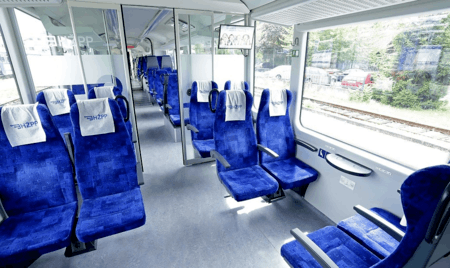
Main technical specifications
- Gauge: 1435 mm
- Catenary supply voltage: 25 kV, 50 Hz
- Axle arrangement: Bo'2'2'2'Bo'
- Seating capacity: up to 220
- Standing capacity (4 pers./m2): up to 300
- Floor height: 600 mm
- Door width: 1300 mm
- Overall length: 75 m
- Vehicle width: 2885 mm
- Vehicle height: 4280 mm
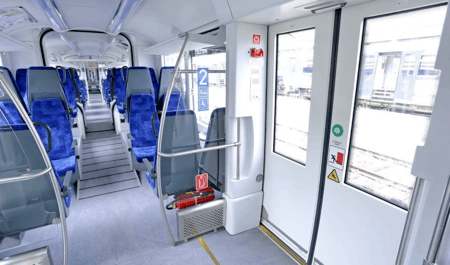
- Maximum weight: 172 t
- powered bogie: 2700 mm
- trailer bogie: 2700 mm
- Bogie wheel base
- Continuous power (on wheel): 2000 kW
- Starting traction force: 200 kN
- Max. acceleration at gross weight: > 1 m/s2
- Max. deceleration: > 1,3 m/s2
- Maximum speed: 200 km/h
References
| Wikimedia Commons has media related to HŽ Class 6112. |
http://www.koncar-kev.hr/docs/koncarkevEN/documents/24/2_1/Original.pdf
- ↑ http://www.koncar.hr/docs/koncareiHR/documents/52/Original.pdf
- ↑ "Kosor provozala novi vlak: Željeznica mora biti jedan od stupova gospodarstva" [Kosor takes new train for a spin: Railway must be one of pillars of the economy] (in Croatian). Nacional (weekly). 3 July 2011. Archived from the original on 1 July 2012. Retrieved 1 July 2012.
